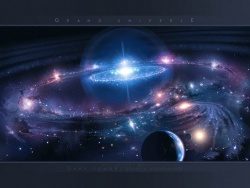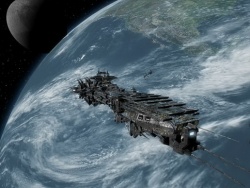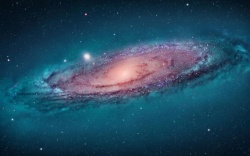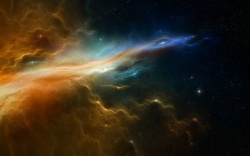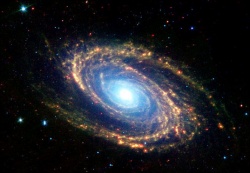Tossing Coins And the End of Time in an Ever Inflating Multiverse
The immeasurable cosmos... the universe, the world; we so-called modern human beings have been conditioned to see the world around us as unitary: The One Almighty, the Only Truth, the Master of the Universe, the Center of the Universe, etc.
But this seems to be just another delusion. What if there are more "universes"? The term for multiple universes is Multiverse or Meta-universe. Those terms were first coined in 1895 by the American philosopher and psychologist William James. Yet the idea of a Meta-universe preceded him by millennia.
Since ancient times Indian Hinduist and Buddhist cosmology is adhering to a worldview including many worlds, both visible and invisible. Hinduism speaks of Triloka -- the Three Worlds. The Vedic rishis describe those as three intertwined dimensions of existence.
A1. The physical world (Bhuloka) is the world of gross or material substance in which phenomena are perceived by the five senses. It is the most limited of worlds, the least permanent and the most subject to change.
A2. The subtle world (Antarloka) is the mental-emotional sphere where we function in through and feeling. Human being dwell in this world during sleep and after death. It is the astral world that exists within the physical plane.
A3. The causal world (Sivaloka) pulsates at the core of being, deep within the subtle plane. It is the superconscious world where the Devas (Gods) and highly evolved beings live and can be accessed through yogic exercises and worship.
The worlds end at Mahapralaya, [the science of physical cosmology calls something similar "the Big Crunch"] when time, form and space dissolve in Siva - the destroyer AND creator - only to be created again in the next cosmic cycle. Hindus regard that which ends as relative Reality to distinguish it from absolute or unchanging Reality.
In Buddhist cosmology, the Triloka (known in Tibetan as: Khams-gsum) are :
B1. The world of desire (Kāmaloka or Kāma-Dhatu; Tibetan: dod pa'i khams) typified by sexual and other desires, populated by different types of sentient beings: hell beings, animals, hungry ghosts (Sanskrit: Preta प्रेत; Tibetan: Yi-dwag), human beings, demi-gods (Sanskrit: Asura असुर; Tibetan: Lha-Mayin) and desire-gods (Sanskrit: Devas देव or Suras; Tibetan: Lha). The last ones are understood to be supernatural beings who with their non-omnipotent and non-immortal qualities resemble a bit the ones populating the Greek pantheon. The Devas are a highly hierarchical bunch: there are higher Devas living in four heavens that float in the air, leaving them free from contact with the strife of the lower world. They are:
- The Parinirmita-vaśavartin Devas, luxurious devas to whom Māra belongs
- The Nirmāṇarati Devas
- The Tuṣita Devas, among whom Maitreya lives. He will at the appropriate time be reborn as a human being and thus become the future Buddha Maitreya, a kind of Buddhist messiah.
The lower Devas of Kāmaloka live on different levels at the center of the physical world, known as Sumeru or Mount Kailash (Tibetan name: Kang Tise) and located in Western Tibet. They are even more passionate than the higher Devas, and do not simply enjoy themselves but also engage in strife and fighting. They are:
- The Trāyastriṃśa Devas, who live on the peak of Sumeru and are something like the Olympian gods. Their ruler is Śakra.
- The Cātur-mahārājika-kāyika Devas, who include the martial kings who guard the four quarters of the Earth. The chief of these kings is Vaiśravaṇa, but all are ultimately accountable to Śakra. They also include four types of earthly demi-god (Asuras) or nature-spirit: Kumbhāṇḍas, Gandharvas, Nāgas and Yakṣas, and probably also the Garuḍas.
The world of desire consists of 36 abodes from the Incessant Hell up to Mastery Over Others' Creations: the six abodes of desire-gods, the 12 abodes of human beings, the abodes of animals and of hungry ghosts (Sanskrit: Preta प्रेत; Tibetan: Yi-dwag), and the 16 hells. When the notoriously materialistic power-hungry demi-gods (Sanskrit: Asura असुर; Tibetan: Lha-Mayin) are classified separately, there are 37 abodes.
B2. The world of form (Rūpaloka or Rūpa-Dhatu; Tibetan: gzugs khams) with the Seventeen samsaric heavenly abodes consisting of the threefold four Dhyana Realms and the five Pure Abodes. A subtle divine state of samsaric existence between the desire realm and the formless realm, where sense of smell, sense of taste and sexual organs are absent. The beings there have bodies of light, long lives and no painful sensations. Unwholesome mental factors such as attachment cannot arise. The Devas (Tibetan: Lha) in that world have physical forms, but compared to their counterparts in the world of desire (Kāmaloka or Kāma-Dhatu; Tibetan: dod pa'i khams) are sexless and passionless. They live in a large number of "heavens" or deva-worlds that rise, layer on layer, above the earth. These can be divided into five main groups:
- The Śuddhāvāsa Devas are the rebirths of Anāgāmins, Buddhist religious practitioners who died just short of attaining the state of Arhat (Brahma Sahampati, who appealed to the newly enlightened Buddha to teach, was an Anagami from a previous Buddha). They guard and protect Buddhism on earth, and will pass into enlightenment as Arhats when they pass away from the Śuddhāvāsa worlds. The highest of these worlds is called Akaniṣṭha.
- The Bṛhatphala devas remain in the tranquil state attained in the fourth dhyāna.
- The Śubhakṛtsna devas rest in the bliss of the third dhyāna.
- The Ābhāsvara devas enjoy the delights of the second dhyāna
- The Brahmā devas (or simply Brahmās) participate in the more active joys of the first dhyāna. They are also more interested in and involved with the world below than any of the higher devas, and sometimes intervene with advice and counsel.
B3. The world of formlessness (Arūpaloka or Arūpa-Dhatu; Tibetan: gzugs med kyi khams). The abode of unenlightened beings who have practiced formless meditative states, dwelling on the notions: Infinite Space, Infinite Consciousness, Nothing Whatsoever, and Neither Presence Nor Absence (of conception). These beings remain in these four subtle types of conceptual meditation for many aeons after which they again return to lower states within samsara. The Devas in this world have no physical form or location, and they dwell in meditation on formless subjects. They achieve this by attaining advanced meditational levels in another life. They do not interact with the rest of the Buddhist cosmos.
N.B. Buddhas and Bodhisattvas are all reincarneted humans and classified as higher beings than Devas.
The existence of Multiple worlds as described above, which was regarded until a few decades ago only esoteric and unscientific mumbo-jumbo, is now taken more seriously by scientific cosmologists and theoretic physicists.
American physicist Hugh Everett's (1930-1982) so-called "Many-Worlds Interpretation" (MWI) was one of the first in 1957. MVI is also known as the Everett interpretation, the many-universes interpretation or "Many Worlds". This theory views Reality as something comparable to a tree that branches out, and wherein every possible quantum outcome becomes on branch of Reality.
Parallel Universes
Swedish-American cosmologist Max Tegmark (born 1967) provided classifications of the expanding, inflating 'invisible worlds' beyong our 'real' universe (the one we human beings can experience with our ordinary senses and which is equivalent to the Hinduist Bhuloka [A1 here above] and Buddhist Kāmaloka [B1 here above]). According to Tegmark's theory, the multiverse resembles some kind of huge loaf of rising dough that is continuously expanding. However like in every piece of rising bread there remain some empty bubbles. In the multiverse that would be regions of space that stop stretching outwards or inflating. Such bubbles are understood as "embryonic level I multiverses."
Theoretical physicists Vitaly Vanchurin and Andrei Linde of Stanford Univerity tried in 2009 to calculate the number of all possible universes. Their result was that the multiverse was consisting of 10^10^16 possible parallel universes.
The physorg.com site elaborates:
- Requiring that the human brain must be able to count the number of parallel universes may seem inappropriate, if not arrogant, but Linde and Vanchurin explain that dealing with the quantum world is different than our everyday lives in which quantum effects can be safely ignored. A crucial part of their calculation here is an investigation of quantum effects on supergalactic scales. In this kind of scenario, the state of the multiverse and observations made by an observer are correlated (similar to the Schrodinger cat experiment, where the outcome can be determined only after it is registered by a classical observer).
- "When we analyze the probability of the existence of a universe of a given type, we should be talking about a consistent pair: the universe and an observer who makes the rest of the universe 'alive' and the wave function of the rest of the universe time-dependent," the scientists write.
- As the scientists explain, the calculation of the number of universes is an important step toward an even larger goal: to find the probability of living in a universe with a particular set of properties. What are the chances that we live in a world in which the laws of physics are these laws that we currently observe? Answering this question requires finding probabilities that depend on knowing about other universes, among many other challenges.
Intrigued by the fact that almost all inflationary models of the multiverse seemed to lead to eternal inflation and implying that time had to come to an end, Vanchurin and Alan H. Guth of Massachusetts Institute of Technology, tried in August 2011 to design models of inflation that are not eternal and where time does not end at a certain "cut off". Their complete research paper can be found under:
http://arxiv.org/PS_cache/arxiv/pdf/1108/1108.0665v1.pdf
The following article by Amanda Gefter and first published August 11, 2011 in NS, may provide some additional elucidation:
Time need not end in the multiverse
GAMBLERS already had enough to think about without factoring the end of time into their calculations. But a year after a group of cosmologists argued that they should, another team says time need not end after all.
It all started with this thought experiment. In a back room in a Las Vegas casino, you are handed a fair coin to flip. You will not be allowed to see the outcome, and the moment the coin lands you will fall into a deep sleep. If the coin lands heads up, the dealer will wake you 1 minute later; tails, in 1 hour. Upon waking, you will have no idea how long you have just slept.
The dealer smiles: would you like to bet on heads or tails? Knowing it's a fair coin, you assume your odds are 50/50, so you choose tails. But the house has an advantage. The dealer knows you will almost certainly lose, because she is factoring in something you haven't: that we live in a multiverse.
The idea that our universe is just one of many crops up in a number of physicists' best theories, including inflation. It posits that different parts of space are always ballooning into separate universes, so that our observable universe is just a tiny island in an exponentially growing multiverse.
In any infinite multiverse, everything that can happen, will happen - an infinite number of times. That has created a major headache for cosmologists, who want to use probabilities to make predictions, such as the strength of the mysterious dark energy that is accelerating the expansion of our own universe. How can we say that anything is more or less probable than anything else?
One procedure physicists are fond of is to draw a cut-off at some finite time, count up the number of events - say, heads and tails - that occur in the multiverse before the cut-off time, and use that as a representative sample.
It seems reasonable, but when tackling the casino experiment, something strange happens. Wherever the cut-off is drawn, it slices through some of the gamblers' naps, making it appear as if those gamblers simply never woke up. The longer the nap, the more likely it is to be cut off, so if you do awaken, it's more likely that you have taken a shorter nap - that is, that you flipped heads. So even though the odds seemed to be 50/50 when the coins were first flipped, heads becomes more probable than tails once you and the other gamblers wake up. "This thought experiment was unbelievably perplexing at first, because it seemed like probabilities were changing from one instant to the next without any explanation," says Alan Guth of the Massachusetts Institute of Technology, who along with Vitaly Vanchurin of Stanford University in California, came up with the conundrum two years ago.
Last year, Raphael Bousso at the University of California, Berkeley, and colleagues devised an explanation that was effective, if unsettling. The changing probabilities were behaving as if time ends at the cut-off, they said, because time really does end at the cut-off. That's why the initial 50/50 odds change when you wake up from your nap.
Upon waking, you have new information: you know that time didn't end. That now means it is more likely that you only slept for a minute than for an hour. After all, time could end at any minute, and an hour has an extra 59 of those to spare. Heads wins.
The idea that time must end for the probabilities to make sense has been bugging Guth and Vanchurin for the last year. Now they say they have developed a mathematical explanation for the multiverse that saves the fourth dimension (arxiv.org/abs/1108.0665).
The essence of the argument is that you don't need any new information, in this case the fact that you woke up, to understand why the odds are no longer 50/50. In a multiverse that grows exponentially, where each new generation of universes is far larger than the last, younger universes always outnumber older ones. Waking up, you will either be in a universe in which 1 minute has passed (heads), or in a universe in which 1 hour has passed (tails). "The experiment sets up a 59-minute ambiguity in the age of the universe," Guth says. "You should always bet on the younger one."
But Bousso doesn't feel safe just yet: "Nature has often seemed crazy as we discovered how far removed its workings are from our everyday intuition. The end of time may sound crazy, but it is by far the simplest interpretation." Whether or not time is going to end, there's a lesson to take from the debate: should you wake up in Las Vegas, bet heads.
